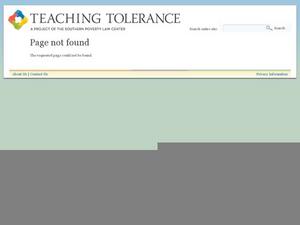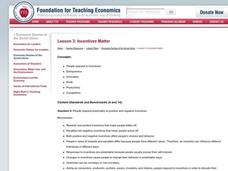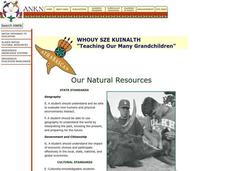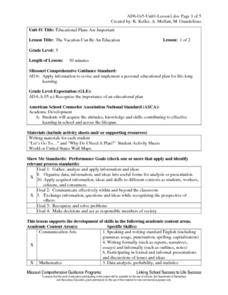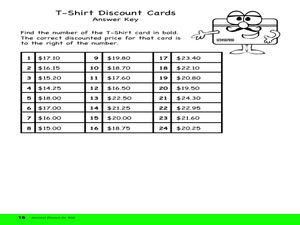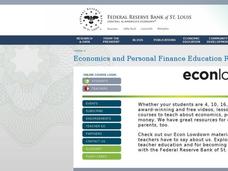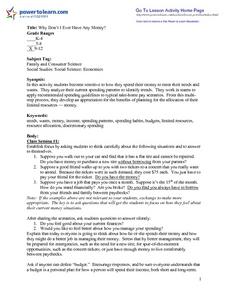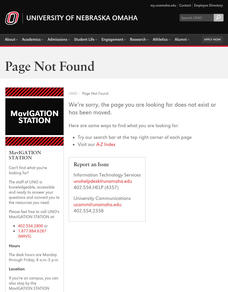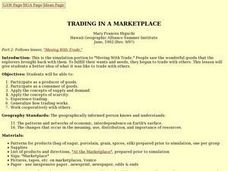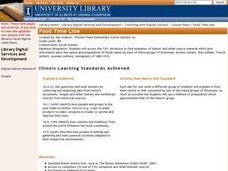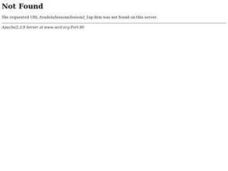Curated OER
Hidden Messages: The Growth of Product Placement
Pupils identify product placements they see in TV programs and movies. They build awareness of the pervasiveness of advertising in their culture. They develop critical skills necessary to think independently in a media saturated consumer...
Curated OER
American Industry Growth
Eleventh graders explore the economic growth from 1878 to 1893. In this social studies instructional activity, 11th graders discuss how the improvements lead to an inequality in wealth and the problems that it caused.
Curated OER
Injustice on Our Plates: Immigrant Women
Students investigate the plight of undocumented workers. In this social justice lesson, students research undocumented workers as well as consumer boycott movements and write about their impressions.
Curated OER
On the Line
High schoolers view a television program that traces the use of the assembly line in mass production and the subsequent conflict between workers' rights and management. They analyze and discuss the portrayal of the American worker over...
Curated OER
Incentives Matter
Middle schoolers identify what motive people. They will learn about both positive, and negative incentives. They will use this knowledge to make predictions about how people will behave. They will apply this knowledge to economics.
Curated OER
Inside the Vault-Entrepreneurship
Students explore entrepreneurship. In this economic study lesson, students take a pretest on attitudes, review characteristics that make up an entrepreneur, review a list of famous entrepreneurs, and create a 5 minute oral presentation...
Curated OER
Save Our Forests
Fifth graders discuss the forest products industry and its affects upon their communities. They inventory the wood and paper products they consume and determine how it translates into the number of trees cut. Using a spreadsheet, they...
Curated OER
Our Natural Resources
Students discuss key terms used to describe ecosystems and how humans are altering natural resources. They listen to the book, Grandfather's Wisdom, and list the renewable and nonrenewable resources they have used or consumed in the past...
Curated OER
Using Credit and Spending Money Wisely
Students discuss how to spend money wisely. In this consumer math lesson, students read the book, Mr. Popper's Penguins and discuss how much it costs to take care of a pet. Students complete a worksheet to calculate the total cost of pet...
Curated OER
Can't You Make Them Behave, King George?
Fifth graders describe the changes in King George III's policy toward the American colonies by sequencing key events between the French and Indian War and the American Revolution. They explain the colonial reactions to command decisions...
Curated OER
FACS:Puppet Factory (Mktg)
Students explore marketing strategies while producing a hand-sewn puppet. They obtain information about child care and safety as well as basic hand sewing techniques.
Curated OER
Eat Your Fruits and Vegetables
Students will discuss the benefits of eating healthy. In this healthy diet lesson, students will discuss the importance of eating fresh fruit and vegetables when pregnant or breastfeeding and how to identify healthy fruits and...
Curated OER
The Vacation Can Be An Education
Fifth graders are given a worksheet in which they choose a location they would like to visit. As a class, they brainstorm a list on what needs to be done before they go on their trip and why it is important to have a plan. To end the...
Curated OER
Wise Shoppers
Students complete several activities to learn about currency and the functions of money. In this money functions lesson, students complete activities to learn what are the functions of money. Students calculate item prices with...
Curated OER
Cards, Cars and Currency
Students investigate the deals presented with cards. In this math lesson, students investigate the pros and cons of having a credit card. They calculate interest and fees for credit cards.
Curated OER
Why Don't I Ever Have Any Money?
Students keep a journal on their current spending habits. In groups, they develop guidelines for a family to follow given a specific amount of take home pay. They role play various scenerios to see what can be done with a given amount...
Curated OER
Sustainable Dining
Students identify consumer products and sustainable foods. They calculate the differences in prices and applying those prices to the cost of a meal. They also discuss the costs and benefits of buying sustainable products.
Curated OER
"Working in a Hat Factory"
Students analyze the understanding of what a producer is. Students distinguish between producers and consumers. Students produce a hat of his/her own. Students will share creations with each other.
Curated OER
Couch Potatoes Around the World#138
Students identify potato chips as a consumer product and investigate what processes are needed to make the chips. They investigate where the potatoes are grown and harvested before being made into chips at a processing plant. They make a...
Curated OER
How Can Business Profit from Tariffs? p1
Students investigate the impact of tariffs on businesses and consumers during the 1880s by looking at a political cartoon, solving a short math problem and comparing protectionism in the 1980's to protectionism in the 1880's.
Curated OER
Trading in a Marketplace
Students complete a trade simulation in a marketplace. In the simulation, they role play the role of producer and consumer of goods and apply the concepts of supply and demand. In groups, they discover how an environment can affect the...
Curated OER
In the Chips
Learners explain how markets work and the role of prices within markets is an important key to being able to explain and predict economic behavior. In true markets, prices are determined by the interaction of buyers and sellers.
Curated OER
Food Time Line
Fourth graders make a timeline to include the immigrants of 1880-1910. Then, in groups, they research foods consumed, purchase, and serve it to the class.
Curated OER
Trade Gives Us Access to Things We Wouldn't Otherwise Have
Students work together in groups to research an item related to trade. They decide on an item that they use and determine where it comes from. They track the sources and consumers on a map.


